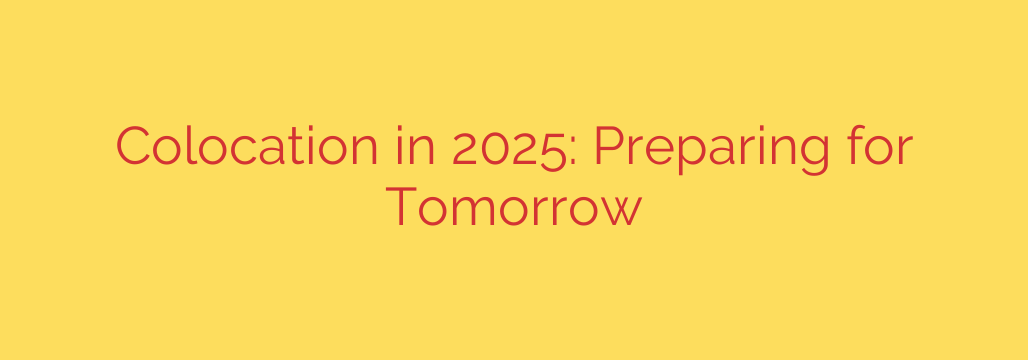
The Future of Colocation: 5 Key Trends Shaping Data Centers in 2025
It’s no secret that the digital landscape is evolving at a breakneck pace. From the explosion of artificial intelligence to the ever-expanding Internet of Things (IoT), the demands on our digital infrastructure have never been greater. At the heart of this transformation lies the colocation data center—no longer just a facility for rack space and power, but a strategic hub for innovation, connectivity, and growth.
As we look toward 2025 and beyond, the colocation industry is undergoing a profound evolution. Businesses planning their IT strategy must understand these shifts to make informed decisions that will support their future needs. Here are the five key trends defining the next generation of colocation.
1. The Unstoppable Rise of AI and High-Density Computing
Artificial intelligence and machine learning are no longer niche technologies; they are core components of modern business. These workloads require immense computational power, which generates a significant amount of heat. Consequently, the days of a standard 5-10 kW per rack are fading.
We are entering the era of high-density computing, where racks consuming 50 kW or more will become increasingly common. To handle this, colocation providers are moving beyond traditional air cooling. Future-ready data centers are actively investing in and deploying advanced liquid cooling solutions, such as direct-to-chip or immersion cooling, to manage extreme heat loads efficiently. When evaluating a provider, their roadmap for supporting high-density deployments is a critical factor.
2. The Edge Takes Center Stage
While massive, centralized data centers remain crucial, the demand for real-time data processing is fueling the growth of edge computing. Technologies like 5G, IoT, and autonomous vehicles can’t afford the latency that comes from sending data hundreds of miles to a central cloud for processing.
The solution is to bring compute and storage closer to where the data is generated—the “edge” of the network. Colocation is evolving to a distributed model, with providers building smaller, highly connected edge data centers in Tier 2 and Tier 3 markets. This hybrid approach allows businesses to run latency-sensitive applications locally while leveraging larger, core data centers for heavy-duty processing and storage.
3. Sustainability is No Longer an Option, It’s a Requirement
The immense power consumption of data centers has put the industry under an environmental microscope. Today, sustainability is a top priority, driven by corporate social responsibility, regulatory pressure, and customer demand.
Leading colocation providers are aggressively pursuing green initiatives. This includes everything from powering facilities with renewable energy sources like solar and wind to designing hyper-efficient cooling systems. A key metric to watch is Power Usage Effectiveness (PUE), where a score closer to 1.0 indicates superior efficiency. Choosing a partner with a demonstrated commitment to sustainability and a low PUE is not just good for the planet—it’s a smart business decision that can lead to lower operational costs.
4. Security and Compliance are Evolving
Data center security has always been paramount, but the nature of the threats is constantly changing. A multi-layered approach that integrates physical and digital defenses is essential.
On the physical side, expect to see more advanced biometrics, AI-powered video surveillance, and stringent access protocols. On the cybersecurity front, the focus is on providing a robust, secure ecosystem. Top-tier colocation facilities offer built-in services like DDoS mitigation, managed firewalls, and secure, private connections to major cloud providers. Furthermore, adherence to strict compliance standards like SOC 2, ISO 27001, HIPAA, and PCI DSS is non-negotiable for protecting sensitive data.
5. Colocation as the Hub for Hybrid and Multi-Cloud
Very few organizations operate entirely in the public cloud or entirely on-premises. The dominant strategy is hybrid IT—a flexible mix of private infrastructure and one or more public clouds (multi-cloud). In this complex environment, colocation serves as the critical intersection.
Modern colocation is the connective tissue for hybrid IT, offering low-latency, secure, and cost-effective direct connections to cloud giants like AWS, Microsoft Azure, and Google Cloud. By placing infrastructure in a colocation facility with rich cloud on-ramps, businesses can build a seamless and high-performance hybrid architecture that combines the security of private hardware with the scalability of the public cloud.
Preparing Your Business for the Future
As you plan your infrastructure strategy, it’s vital to partner with a colocation provider that is not just meeting today’s needs but anticipating tomorrow’s challenges. When vetting potential partners, ask these key questions:
- Density and Cooling: What is your roadmap for supporting high-density, AI-driven workloads? Do you offer liquid cooling solutions?
- Edge Strategy: Do you have a presence or a plan for edge locations to support low-latency applications?
- Sustainability: What are your PUE ratings, and what percentage of your power comes from renewable sources?
- Connectivity: What cloud on-ramps and carrier options are available to build a robust hybrid cloud environment?
- Security: What certifications do you hold, and what advanced cybersecurity services do you offer?
The colocation industry is moving far beyond its traditional role. By understanding these trends, your business can leverage a data center partner not just for space and power, but as a strategic asset that fuels innovation and secures your digital future.
Source: https://www.datacenters.com/news/enterprise-colo-in-2025-is-your-current-provider-ready-for-the-future








